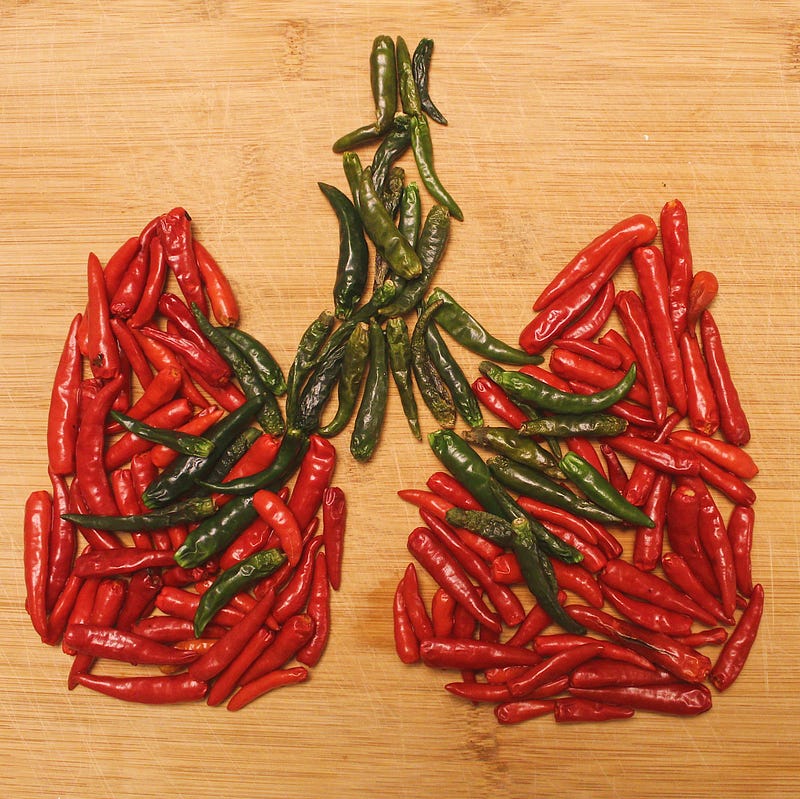Capsaicin Igniting the Trail to Extinguish Lung Cancer
Does the chemical in chili peppers have the potential to slow the growth and spread of lung cancer?
By Cailey Denoncourt, Bioengineering, 2022

The burning, eye-watering taste of a chili pepper is an experience only some enjoy. Capsaicin is the active ingredient that makes chili peppers so hot and an extreme irritant in high concentrations. Recently, scientists have noticed an unusually low rate of lung cancer in countries with traditionally spicy food. Thus, capsaicin could be more than a key ingredient in some amazing dishes; in the lab, it is being examined for potential benefits for those with lung cancer.
In very small concentrations, capsaicin has already been used in ointments for pain relief, but its medicinal purposes continue to expand. In particular, the molecule has anti-neoplastic properties in a variety of human cancer cells. This means that it could both inhibit and prevent the development of tumors. Research has indicated capsaicin’s potential role in apoptosis (cell death) of cells for non-small-cell lung cancer (NSCLC), T-cell leukemia, prostate cancer, colon cancer, and more. But further, cancer becomes deadly and extremely difficult to treat when it spreads, or metastasizes, to other organs in the body. To fight against this, capsaicin has also been shown to inhibit the cell cycle of cancer cells, thus preventing tumor growth both within the primary organ and in a potential secondary organ.
In very small concentrations, capsaicin has already been used in ointments for pain relief, but its medicinal purposes continue to expand.
Although capsaicin has many medicinal benefits, the chemical also comes with some adverse side effects. Patients may experience gastrointestinal irritation, stomach cramps, nausea, skin redness, vomiting, or burning diarrhea, along with other possible symptoms. However, with limited studies in the potential long-term side effects of capsaicin on patient health, there still remains a lot of unknowns. Thus, research on capsaicin-like molecules is being examined for potentially maintaining its anti-neoplastic benefits, while reducing the negative side effects.
At the Experimental Biology meeting in April 2019, Jamie Freidman, a recent PhD graduate in Piyali Dasgupta’s lab at Marshall University, reported the investigation into the effects of capsaicin and other capsaicin-like compounds on lung adenocarcinoma, which is a specific form of lung cancer that forms in glands allowing it to easily spread and metastasize. The two derivative molecules of capsaicin Friedman is working with are capsiate and capsiconiate. Both only have minor changes compared to the structure of capsaicin, and hence their bioactivity closely resembles that of capsaicin. In their study, the mouse models that had capsaicin in their diet showed a significant decrease in the metastatic area in the lung, indicating a decrease in the growth of the tumor. When observing the effects of capsiate and capsiconiate through the examination of invasion assays, capsiate successfully showed anti-invasive properties.
However, with limited studies in the potential long-term side effects of capsaicin on patient health, there still remains a lot of unknowns.
More recently, in October 2019, Friedman published a review investigating the effects capsaicinoids, derivatives of capsaicin, have on metastases. One characteristic of tumors is the formation of new blood vessels, called angiogenesis, which causes the tumor to take the oxygen and nutrients from cells that are vital for organ function. A study by Min et al. in 2004 showed how capsaicin suppressed the production of vascular endothelial growth factor, thus preventing the growth of these new blood vessels. Therefore, without the proper nutrients, the tumor is unable to grow and spread. This result was also similarly found in capsaicin derivatives like capsiate.
Another critical step in tumor metastasis is known as the epithelial-to-mesenchymal transition (EMT). In order for the secondary tumor to form, the cells must be able to travel through the body without being deemed a foreign enemy by the immune system. Thus, part of the EMT is the removal of markers that specify the cells to their primary region and replace these membrane markers with mesenchymal markers, which are applicable to a greater range of cell types. In 2013 Yang et. al. found that capsaicin supported the EMT transition, whereas in 2014 Wutka et. al. found that capsaicin did the exact opposite.
The overall effects of capsaicin remain unknown and controversial. For every study supporting the positive effects of capsaicin in slowing the growth and spread of tumors, there is another study demonstrating the reverse. Thus, research continues to examine the question: is capsaicin a key in the treatment of cancer? It’s a hot debate.
PLOS ONE (2010). DOI:10.1371/journal.pone.0010243
The FASEB Journal (2019). DOI: 10.1096/fasebj.2019.33.1_supplement.368.1
Biomedicine & Pharmacology (2019). DOI: 10.1016/j.biopha.2019.109317
